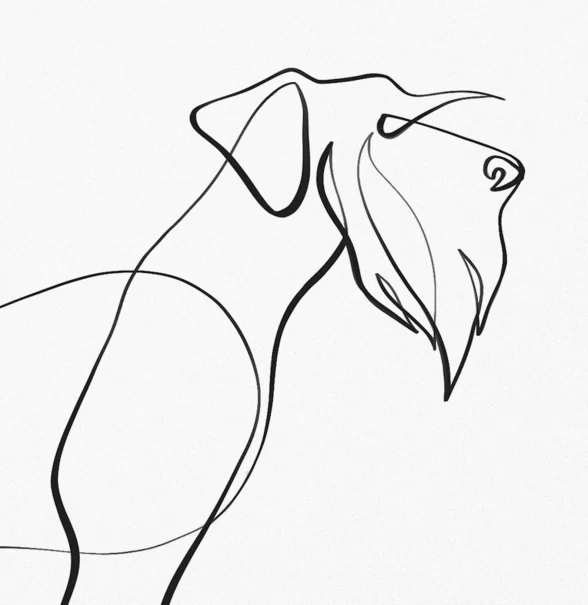
The drawing of the Standard Schnauzer seen here was created with a single, flowing, looping black line left by a brush pen that never left the paper. Dane Khy, the artist of this one-line technique, calls the series of drawings he creates in this manner, “With One Line.”
The process isn’t new, but for Khy, experimenting with the calligraphy-inspired technique helped him deal with the grief of losing his beloved dog years before. Khy has a new dog in his life, a Boston Terrier named “Holly,” but his one-line drawings have been perfected to where we can easily recognize a breed even though it is based on an economy of detail. Put another way, Khy must discern the most important contours and patterns needed to depict a breed, and in this drawing, it is clearly the eyebrows, whiskers and mustache.
It is not a coincidence that the Standard Schnauzer’s AKC breed standard mentions that the hallmark of the breed [are] the arched eyebrows and the bristly mustache and whiskers. These “furnishings” should be of the same harsh texture as the coat: Hard and wiry.
For the show ring, the Standard is a tight and very tailored looking dog, and grooming one involves carding/hand-stripping, blade work, and a practiced eye. In this general discussion, we limit ourselves to an overview of grooming the head, but caution that each groomer may approach it differently, and each dog’s coat may present differently. We add that by no stretch of the imagination is this intended to be instructive. It takes years to learn how to do groom this breed properly for a conformation ring. Our intent is to give a broad (very broad) overview that will leave you in awe of the talent behind a beautifully presented Standard.
The Standard Schnauzer’s head should appear strong and rectangular in shape; hair is clipped from the top of the skull against the grain toward the eyebrows. Those prodigious eyebrows are shaped by following the dog’s eye socket ridge and using curved shears in reverse. The coat is kept very short toward the back of the dog’s eyes, but not only does the coat get longer towards the nose, the brow tips reach the dog’s muzzle at its halfway point. These “arched triangles” allow one to see the dog’s eye expression. Hair between the eyes should form a natural inverted’ V’ that is accentuated by scissoring from the corners of the eyes. Keeping scissors ‘flat’ against the skull is not only safer, it prevents obvious scissor marks. We’re told that the real challenge is in getting the eyebrows even.
This photo of the “beard line,” is self explanatory from the photo. When seen from the front, the cheeks and beard should form a continuous line. The cheeks and throat areas are kept clean with a blade used against the grain. A visual line goes from the corner of the eye (the corner nearest the ears) to the cheek whiskers to the chin, up to the opposite cheek whiskers and the opposite eye.
Are you tired yet?
The outsides of the ears are closely trimmed with clippers, either a #10 or #15, and the insides are shaved with a #40. The ear edges can be tidied up with tiny detail scissors.
In reading about trimming this breed, we learned that some groomers regard the Schnauzer’s groom as the foundation of many other breed styles in the world. Furthermore, one source wrote that if someone can groom a Schnauzer for the ring, they can groom virtually any breed in the world with a few adjustments. We defer to owners and professional groomers on this point, but we can believe it.
If you were to draw your breed with just one line, what aspects would you choose to accentuate that would signal its breed?
We invite readers to share photos of their Standard Schnauzers, particularly those groomed for a show ring. Now that we have a rough idea of what goes into just the head alone, we want to stand back and admire!
Image: Dane Khy’s Standard Schauzer line drawing print may be purchased here where you can also see the entire image (the image seen here is a detail). You can also see more of Khy’s work here
